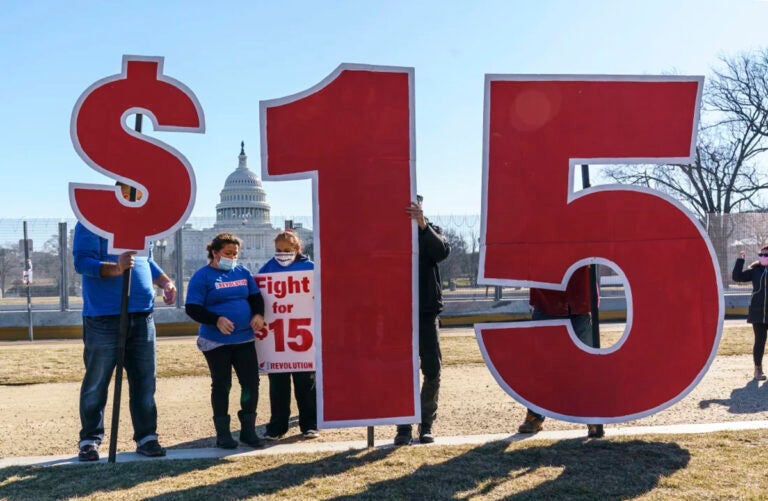21 states are getting minimum wage bumps in 2025
An additional 48 cities and counties will raise their minimum wages above their state wage floors starting Tuesday.

Activists appeal for a $15 minimum wage near the Capitol in Washington in 2021. (J. Scott Applewhite/AP)
Minimum-wage workers in 21 states will see a bigger paycheck come the new year. They’re among the many thousands of laws changing as a new year begins.
Those wage increases will impact an estimated 9.2 million workers and raise pay by a total of $5.7 billion, according to the Economic Policy Institute, a think tank that publishes economic research and examined the expected 2025 wage increases.
An additional 48 cities and counties will raise their minimum wages above their state wage floors starting Tuesday.
California, which is increasing the minimum wage from $16 to $16.50, is one of the 14 states adjusting the minimum to increase for inflation. The average full-time minimum-wage worker in these states will make around $420 more annually, according to EPI.
Five states are bumping up the statewide minimum wage through previously adopted legislation, and two states — Nebraska and Montana — are making changes after voters passed ballot measures.
Research shows that a full-time minimum wage worker earning $7.25 an hour makes just $20 more than the poverty guidelines for a single-person household. Add kids or needing to care for other family members, and that worker falls below poverty levels. Drexel University’s Center for Hunger-Free Communities found in 2021 that “a true living wage” that supports an individual’s basic food and housing needs would be between $20 and $26 or more per hour depending on the state.

Who are most impacted by increases?
Among those most directly benefiting from these wage increases are women and Black and Hispanic workers.
“The January 1 increases show that the minimum wage continues to be a powerful tool for combating racial and gender wage disparities, supporting working families, and reducing poverty,” EPI said in its report.
Women make up almost 60% of workers seeing a raise, according to EPI’s analysis. A little over 11% of workers seeing higher paychecks are Black, and nearly 40% are Hispanic.

But the minimum-wage level may still be too low to keep up with rising prices and home costs, according to EPI. That’s especially the case if a locality’s minimum wage was tied to inflation years ago and has not been reexamined since. EPI pointed to Ohio, a state that last passed a significant increase to its minimum wage in 2007, and that will see it increase this year from $10.45 to $10.70 because of an inflation adjustment.
WHYY is your source for fact-based, in-depth journalism and information. As a nonprofit organization, we rely on financial support from readers like you. Please give today.





